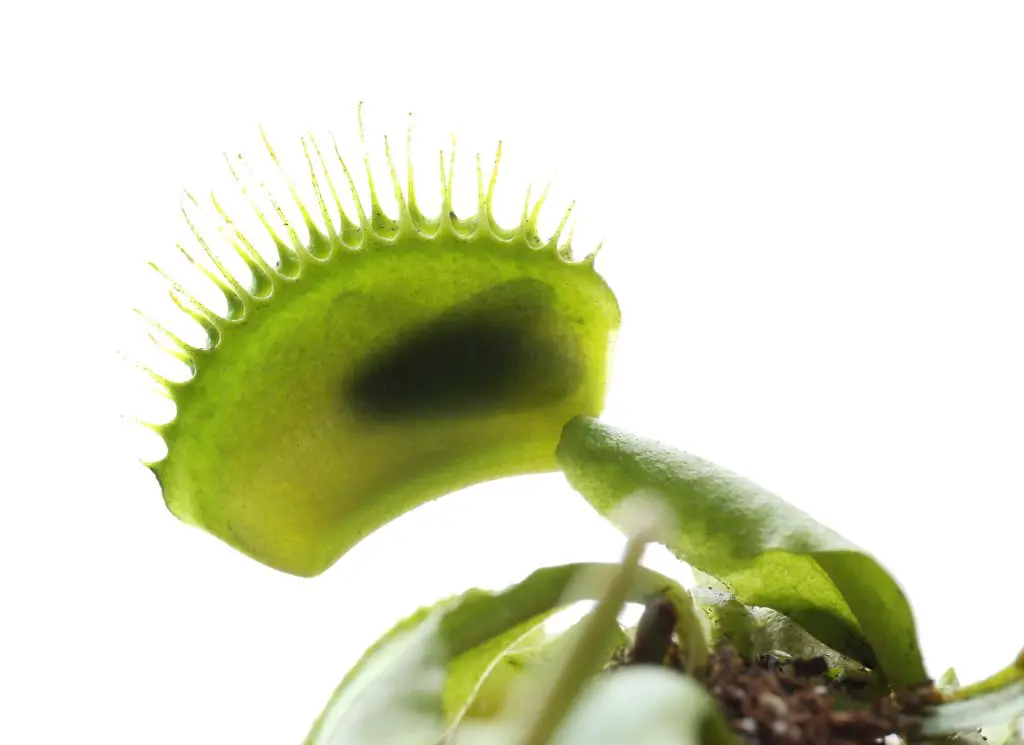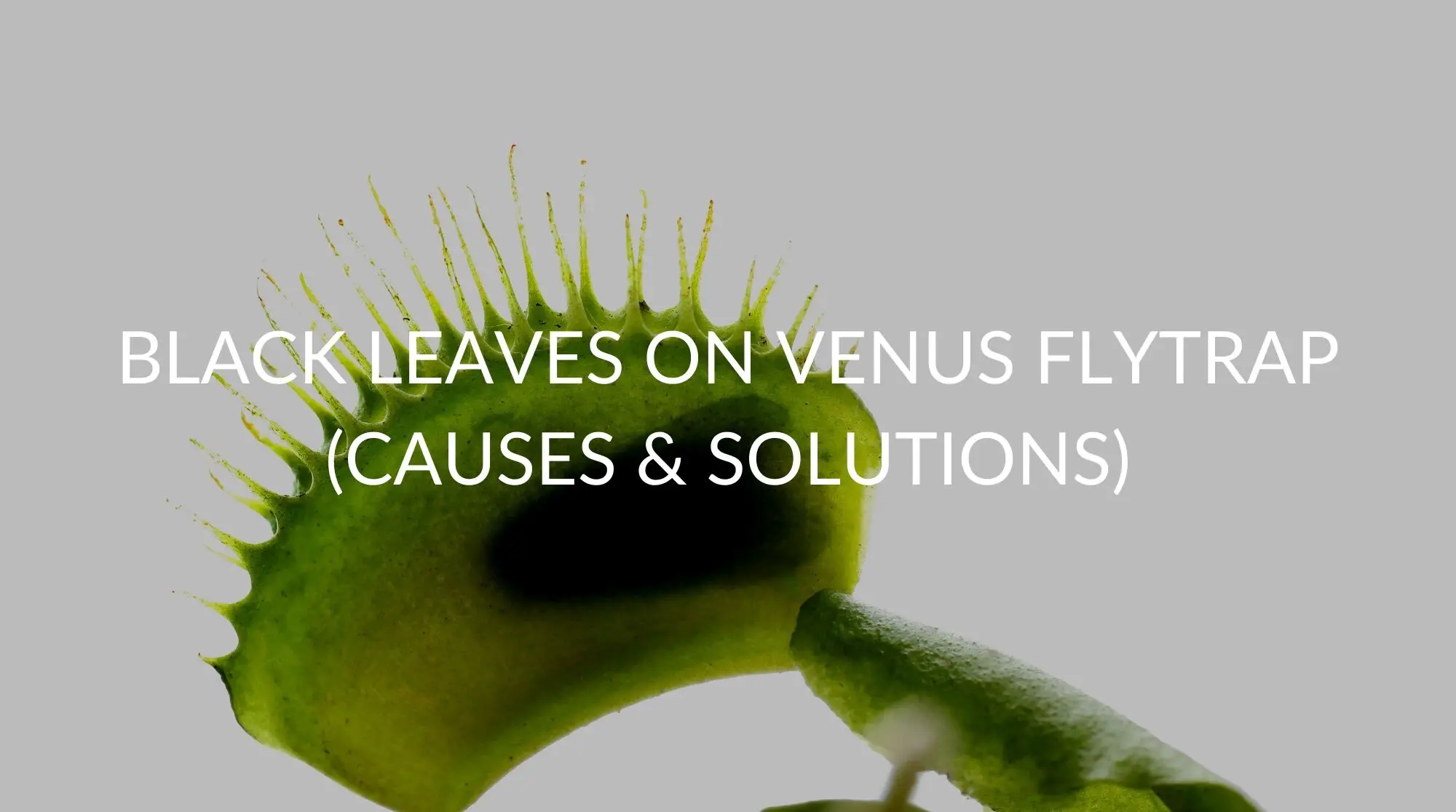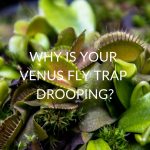Several things can cause your Venus flytrap’s leaves to turn black, and not all of them are a cause for panic. Many causes for the blackening of flytrap leaves are environmental or natural causes. You should closely monitor your Venus flytrap and learn to identify states of winter dormancy to take better care of your plant.
Environment and conditions are critical to the Venus flytrap, which can turn black if planted in unsustainable soil or watered with bad water.
Why Are My Venus Flytrap Leaves Going Black?
A Venus flytrap’s leaves will go black for many reasons. Some reasons are entirely normal, like winter dormancy, where they enter a state of decay. Other problems can happen from owner neglect. The Venus flytrap needs proper care and maintenance to ensure that it does not turn black. You must guarantee to monitor its health closely in cold weather.
Venus flytraps do not use light to break down nutrients. Instead, they trap insects within their leaves to slowly digest them. Supply the Venus flytrap nutrients through food and not soil to prevent the leaves from blackening.
Natural Shedding
Venus flytraps have rhizomes, which store their sugar and energy that continually influence the Venus flytrap to shed its leaves. Shedding leaves is normal behavior that you can treat by pruning the dead traps away. Natural shedding occurs for several reasons, and pruning promotes new growth much quicker than growing naturally.
If your see white mold growing in your Venus Flytrap, it could be a sign of something else.
Winter Dormancy
The Venus flytrap is a temperate plant that becomes dormant during wintertime. When they enter a resting phase, they are not receiving their regular nutrients supply. It is normal for the leaves of a Venus flytrap to simultaneously turn black and die as a bunch.
Inappropriate diet
The Venus flytrap has a very strict diet, meaning you cannot feed it things without disrupting its health. Unknown objects or human foods can turn your Venus flytrap’s leaves black if you feed them to your trap too often. Inappropriate food can include human foods, like meats or cheeses. You must also feed your plant the right amount of food, only ⅓ of the trap’s size.
Underfeeding
Traps that do not get fed enough will sometimes turn black and die because they are nutrient starved. In addition to feeding your plants the right amount, you must also disperse food across the traps evenly. Feed your traps equally at the same frequency. Remember, if you trigger plants for fun without feeding them a meal, they will turn black and die.
Soil Conditions
Venus flytraps prefer growing in poor quality soil. Providing your Venus flytrap with compost or fertilizer can harm your plant since these include boosts of nutrients the plant cannot handle. Instead of soil, Venus flytraps get their nutrients from the insects they consume.
Water Conditions
The type of water you give your Venus flytrap directly impacts its health and can be the leading reason your flytrap turns black. Mineral-rich waters can dissolve your plant’s roots, making it impossible for the flytrap to absorb water. It is important to steer clear of any waters that contain minerals or general ingredients.
Poor Lighting Conditions
Venus flytraps require direct sunlight for a large portion of their day. Poor lighting conditions will cause Venus flytrap leaves to turn black. If you do not intervene quickly when your leaves turn black, your plant will perish.

How To Deal With A Venus Flytrap Turning Black
There are many ways to fix the blackening leaves of a Venus flytrap. So, if your Venus flytrap turns black, it is not always a cause for concern. Your Venus flytrap’s leaves can be largely influenced by diet or environment in many cases.
In addition to taking proper care of your Venus flytrap, you must always evaluate the weather and temperature around your plant. Maintain a comfortable and stable habitat to keep the leaves on your plant from turning black.
Consider diet
Be considerate of the Venus flytrap’s diet and never feed them anything outside their ordinary insect diet, like spiders, beetles, flies, and other insects. Each trap can vary in size as it matures. So, pay close attention and only give the traps insects that are ⅓ of their size.
Use Distilled Water
Use distilled water to water your Venus flytrap instead of tap water. Venus flytraps are very sensitive, and the distilled water has no minerals inside. Hydrate your Venus flytrap generously and wait until you see the color return.
Replant your Venus Flytrap
If your Venus flytrap is turning black because you planted it in nutrient-rich soil, you should replant it in peat moss. Peat moss is nutrient-deprived, so you will never need to worry about overdosing your plant with unnecessary nutrients. Never use regular potting soil. Even this can have too many nutrients for the Venus flytrap and may cause it to blacken and die.
Adjust Venus Flytrap Diet
If you have a feeding issue with your Venus flytrap, consider adjusting your plant’s diet. Give them food that better suits their dietary needs, like high-protein insects.
Wait for the Next Season
When your Venus flytrap goes through its state of dormancy during wintertime, the traps will likely turn black. The best thing you can do at this point is to wait for your plant to grow back in the following season. At the beginning of the following season, expect to see your Venus flytrap spring back to life -pun intended.
Prune your Venus Flytrap
You should always prune black leaves off your Venus flytrap. Otherwise, the dead leaves will slow the growth rate of your plant significantly. Your plant will focus on nutrient delivery to the wrong spot of the plant and cannot rebloom new traps when there is an old dead trap in its way. Prune the old trap away and reveal a place for the new trap to exist.
How To Prune the Black Leaves Off Your Venus Flytrap
The most common way to prune black leaves from Venus flytraps is to carefully cut them at the bulb’s base when the leaf turns entirely black. Remove the whole leaf without touching or removing the trap unless the trap is also black. If the whole trap is black,
Pay attention to the state of the leaves. Generally, a new leaf should grow in its place for every black leaf you remove. If you notice that a new leaf is not already growing in place of the black leaf, it might be a reason for concern.
If your leaf is still brown, try reviving it before pruning. Pruning your Venus flytrap can be a great solution for some problems but not for everything.
Use Scissors to Cut Leaves
With available gardening shears or scissors, cut the black leaves close to the bulb. Cutting is the best possible method for pruning black leaves off your Venus flytrap. Cut close to the bulb, but do not touch the bulb itself, or you might set off the trap.
Never Tear Black Leaves
Tearing black leaves from your plant is not recommended. In most cases, tearing the leaves to prune will tear the plant from the ground. Tearing your plant from the ground will kill the plant. But it is possible to tear dying leaves from your Venus flytrap if you do not have any shears at your disposal.
Don’t Set off Traps
Avoid setting traps while trimming so you do not force your plant to exert unnecessary energy. Activated traps die sooner, so you should leave them alone as long as possible. Be conscious of your hands and the ends of instruments while shearing and cutting black leaves.
Trim All Leaves at Once
When there are several dead leaves on your plant, you should trim them simultaneously. Trimming several black leaves at once will decrease the time to prune your Venus flytrap. Use gardening shears or scissors to trim leaves. Never tear the traps or leaves from the plant.
Uproot Your Venus Flytrap if Necessary
If all leaves in your plant have turned black, the plant might not be salvageable. Carefully poke through the dirt and evaluate the roots. Dead plants will have hollow roots and easily crumble to dust. Remember, never uproot your plants unless it is necessary. Uprooting a Venus flytrap that does not need replanting will significantly shorten your plant’s lifespan because you are adding stress to their lives.
Never Leave their Leaves to Fall off
Never leave dead leaves or traps on your plant, or you will force your plant to spend excess energy sending nutrients to a part of its system that does not need it. Plants can spend their excess energy on other things like catching and digesting their food.
How Do I Keep My Venus Flytrap Leaves From Turning Black?
Keep Venus flytraps from turning black by feeding them a proper diet and planting them in a hospitable environment. A hospitable environments mean that your Venus flytrap is planted somewhere with great soil and watered with good, sustainable water. You must also provide your Venus flytrap with plenty of sunlight.
If you do not keep your Venus flytrap in a sustainable environment, its leaves will likely turn black and then die. You can keep the
Feed the Proper Diet
You must feed your Venus flytrap a proper diet of insects that will offer them the nutrients they do not get from their nutrient-deprived soil. Never feed your Venus flytrap any type of human food, including any meat product.
Plant in Peat Moss
Plant your Venus flytrap in peat moss, a nutrient-deprived soil, for the most successful growth. Peat moss is a dead material that can be difficult for most plants to survive in. The Venus flytrap will thrive here because the carnivorous plant gains nutrients from the insects it feasts on and not its soil.
Feed Correct Size Food
When feeding your Venus flytrap, always consider the size of the food you feed your Venus flytrap. If necessary, break the food into pieces to accommodate the trap size. Feeding your Venus flytrap food that is too large can cause their traps and leaves to turn black from nutrient deprivation.
Use Good Water
Use only distilled water to water your Venus flytrap. Other types of water can be full of impurities that can damage your plant. Using good water promotes positive growth and can strengthen your Venus flytrap’s health.
Keep Your Plant in Light
Venus flytraps require direct sunlight. If you do not have enough lighting, your traps could blacken and die. Keeping your plant in direct sunlight will ensure that it survives year-round. Some places in the United States allow you to keep plants outdoors nearly year-round.
Never Avoid Cold Weather
Never try to prevent winter dormancy, or you might shorten your plant’s lifespan. Venus flytraps typically fall into dormancy when temperatures fall below 45 degrees Fahrenheit. Keeping your Venus flytrap in a greenhouse during cold weather or bringing it indoors will prevent the leaves from turning black for several years can cause your leaves to turn black and die.
Black Leaves Vs. Yellow Leaves In Venus Flytraps
Leaves will yellow before they blacken. Pay attention to signs of yellowing. These could be signs that your leaves are dying. If you see yellow leaves on your plant, this is one of the first indicators that it may need better watering or lighting routines. Browning of the leaves shows it is thirsty.
Improve the quality of your plant’s life to decrease the yellowing of their leaves and bring them back to life. You can use several methods to increase the quality of your Venus flytrap’s life by reversing the yellowing effects, so their leaves do not turn black.
In some cases, yellowing is normal and nothing to worry about. If your plant is aging, you may begin to see signs of yellowing, and there is no reason to try and reverse these effects for any reason.
Yellow Leaves Aren’t Dead
Yellow leaves aren’t dead yet, meaning you have time to revive them and bring them back to life. Nurse your plant carefully, and you should see the results within a few weeks. In fact, some cures may show overnight, like watering your plant, which can rejuvenate your plant as quickly as one watering.
Increase Water
Increase the amount of water you feed your plant daily. The amount of water intake can directly impact your plant’s health. If you starve your plant of water, they are likely to show yellowing in their leaves.
Blackening Is Normal, So is yellowing.
The blackening of your Venus flytrap’s leaves is a normal response to aging, digestion, and weather. It can happen slowly or suddenly and is generally nothing to worry about since new blooms will typically replace the old ones. On the other hand, yellowing can signify that you do not keep your plant in the proper environment or are not giving it the proper care.
Prune Normally
If you want to prune a yellow leaf from your plant, you should use the same pruning methods that you would use for a dead, black leaf. Use a pair of regular gardening shears or scissors to cut the leaf at the base. Typically, this location is right where the colors change between the dead leaf and the remainder of the living Venus flytrap plant.
FAQ
Should I Cut Off Black Venus Flytraps?
You should cut off black traps on your Venus flytrap, or your plant will continue to send nutrients to dead traps. That will take energy from your plant and nutrients from your traps still living. It is not necessary to cut black traps and leaves off your Venus flytrap.
Why Did My Venus Flytrap’s Leaf Get A Black Spot After I Fed It?
Your Venus flytrap can turn black because of being fed inedible objects, triggered without accessible food, or from old age. Venus flytraps get black spots before dying and turning entirely black. It is much more normal for this to happen after being fed several times.
Recap
Venus flytraps are fragile plants requiring precise growing conditions, like water, temperature, and sunlight. A Venus flytrap’s leaves will turn black when you keep them in unstable conditions or feed them a poor diet aside from their natural insects. As the Venus flytrap goes through the natural cycle, they shed their leaves which begins with the darkening and blackening. Several traps can turn black simultaneously.
Always maintain the right habitat for your Venus flytrap if you expect to raise a healthy plant. Keep your Venus flytraps in the direct light at all times, so your plants can receive the light they need to grow. Otherwise, they may begin to wilt and turn yellow. Luckily, monitoring them closely can help you catch issues as they happen.
Moving forward, you should always treat rehabilitated leaves with extreme caution. Pay them extra attention by maintaining a proper diet and monitoring their environment closely. If you do not feed your Venus flytrap the right diet and keep it in ideal conditions, it is more likely to turn black.








